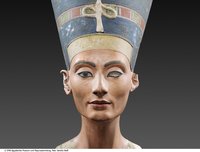Der tiefe Napf steht auf drei zapfenartigen Füßen. Unter dem breiten Rand des Napfes setzt eine gerade Tülle an. Metallgefäße dieser Art wurden vor allem in Friedhöfen Nubiens in hoher Anzahl gefunden. Dieses Exemplar stammt aus einem Familiengrab, in dem mindestens zwei Erwachsene und ein Kind bestattet waren. Die Dekoration auf dem Rand mit stilisierten Weinranken lässt Zweifel an der Interpretation als Schnabeltasse aufkommen. Vielmehr wird es sich um ein hochwertiges Trinkgeschirr gehandelt haben, aus dem möglicherweise Wein genossen wurde.
(J. Helmbold-Doyé)
en

